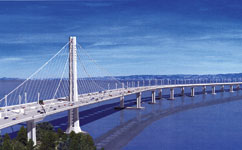A deal struck June 23 between California Gov. Arnold Schwarzenegger (R) and Democratic legislative leaders breathes new life into an innovative but increasingly expensive component of the new San Francisco Oakland Bay Bridge. Now, a second round of requests for proposals for what would be the worlds largest self-anchored suspension span could be issued by the California Dept. of Transportation before the end of July.
Schwarzenegger last year proposed scrapping the SAS design and replacing it with an extension of a 1.1-mile concrete "Skyway" viaduct, now being built (ENR 12/20/04, p. 12). He claimed the move would save $500 million. The viaduct was designed to connect to the suspension bridge and comprise the bridges east span leading to Oakland.
At ENR press time, state legislators were expected to vote soon on the plan to save the design. It would raise Bay Area bridge tolls from $3 to $4 starting Jan. 1, 2007, to cover the bulk of what is now estimated as a $5.6-billion project. The state would contribute $630 million and $800 million would be covered by refinancing debt.
 |  |
| Survival. Skyway foundation work continues during debate over suspension spans fate. (Image courtesy of Caltrans/Photo by Bill Hall) | |
Work on the substructure halted in January while the governor and legislature debated the design. Pending legislative approval, Caltrans will choose among three options for proceeding with the SAS design: restart the SAS marine foundation contract held by Kiewit Pacific Co.-led consortium KFM; rebid the foundation contract; or add the work to the SAS superstructure alternative contract. Because crews removed heavy cranes when the $175-million contract was put in suspended termination in March, costs of restarting the current contract are a factor, says Caltrans toll bridge engineering manager Dan McElhinney. Foundation work is more than 50% complete.
New cost estimates have not been completed but a Caltrans seismic retrofit report issued in March estimates that delays and increases in material prices, especially steel, pushed the price tag for the 530-ft-high, single-pylon structure from $2.6 billion to $5.5 billion plus contingencies. The report estimated that delays were costing taxpayers $400,000 per day. The link is designed by San Francisco-based T.Y. Lin International and Long Beach-based Moffat & Nichol.
An investigation into allegations by 15 workers of deliberately overlooked faulty welds in the Skyway foundations also hampered the overall project. Independent lab tests found no evidence backing that claim (ENR 5/2 p. 12).
The lone bidder for the original SAS superstructure contract was a joint venture including Coraopolis, Pa.-based American Bridge Co.; Aliso Viejo, Calif.-based Fluor Corp., and Japanese company Nippon Steel Bridge. The bid was for $1.8 billion using U.S. steel and $1.4 billion with foreign steelnearly double Caltrans original estimate. McElhinney says a Buy America requirement will not be included in the new package.
He says Caltrans can issue advertisements for new bids within 10 days of the laws signing, with a contractor to be chosen four months later. This time he hopes more contractors will bid. "It is always good for a bidding team to know there is a solid funding package in place," he says. "It adds confidence."
American Bridge CEO Bob Luffy says he must see the final RFP before deciding whether to bid again. "The world has gone around many times and we cant just dust off the estimates and the erection schedules," he says. He estimates it cost millions of dollars to put together the first bid. "It must be a different job or they wouldnt have bid it all over again," he reasons. KFM declined to say whether it would bid on any future work.
Whoever wins the contract will be working under public scrutiny. The proposed deal includes a requirement for an oversight committee made up of local elected officials and Caltrans project managers to ensure that there are "no more surprises," says Randy Rentschler, spokesman for the Metropolitan Transportation Commission.

Post a comment to this article
Report Abusive Comment